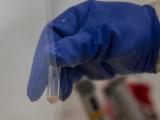Mar 13, 2002 (CIDRAP News) Data on more than 300,000 proteins that may have potential as treatments for anthraxthe fruits of a project in which thousands of personal computers were used to analyze billions of moleculeshave been turned over to the US and United Kingdom governments.
The results of the Anthrax Research Project, an international effort to help scientists find a drug that can block the anthrax toxin, were presented to government officials Mar 8, according to a US Department of Defense (DoD) news release.
The project accomplished in 4 weeks what would have taken years if handled with traditional methods, DoD officials said. "Preliminary indications are that the original pool of 3.57 billion molecules has been narrowed down considerably, having identified over 300,000 crude unique hits in the course of the project," the release states.
Computer users participated in the project by downloading a screensaver that permitted their computers to be used to analyze molecular structures whenever computation resources were available. The program was sponsored by Intel, Microsoft, the University of Oxford (UK), the National Foundation for Cancer Research, and United Devices.
Graham Richards, head of the Oxford chemistry department, presented the results of the project to Anna Johnson-Winegar, deputy assistant to the secretary of defense for counterproliferation and chemical and biological defense, DoD reported.
The anthrax toxin has three componentsprotective antigen, lethal factor, and edema factor. Protective antigen forms a ring that binds with lethal factor, enabling lethal factor to enter cells, the DoD release says. Recent research has pinpointed the site where lethal factor binds with protective antigen and has indicated that the binding can be inhibited, which would prevent toxicity. In the next phase of the search for an antitoxin, the "ranked hits" will be further refined and analyzed, DoD officials said.



















